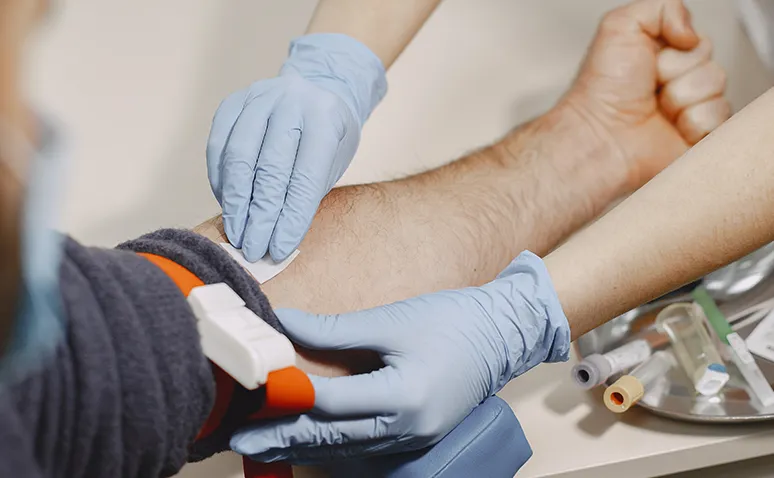Liver diseases include conditions that can disrupt essential functions such as the removal of harmful substances from the body and the storage of nutrients. Changes observed throughout the process are evaluated together with personal medical history and current symptoms.
Liver diseases may develop due to various causes, and the diagnostic process requires interpreting laboratory findings, imaging methods, and physical examination together. A decrease in functional capacity may be associated with factors such as dietary habits, medication use, or genetic predisposition. Correct analysis of symptoms detected at an early stage helps determine the appropriate approach more clearly.
The symptoms of liver-related health problems, which may vary depending on the type of disease, include:
- Abdominal Pain or Discomfort
- Yellowing of the Skin (Jaundice)
- Fatigue and Weakness, Loss of Appetite
- Nausea and Vomiting, Itching (Pruritus)
- Dark Urine, Light-Colored Stool
- Abdominal Swelling (Ascites)
- Swelling in the Legs and Feet (Edema)
- Easy Bruising or Bleeding
- Mental Confusion and Memory Issues (Hepatic Encephalopathy)
- Fever and Signs of Infection
- Spider Veins on the Skin (Spider Angiomas)
- Menstrual Irregularities in Women, Loss of Libido or Gynecomastia in Men

What Are Liver Diseases?
The liver, one of the body’s most important organs, plays critical roles in metabolism, detoxification, and protein production. However, liver diseases can emerge due to various reasons, leading to significant health issues.
Hepatitis is a disease characterized by inflammation of the liver, with types such as Hepatitis A, B, C, D, and E. Viral infections are the most common causes of this disease. Particularly, Hepatitis B and C carry a risk of becoming chronic, potentially leading to cirrhosis and liver cancer.
Fatty liver disease (Steatosis) occurs due to fat accumulation in the liver and is categorized into alcohol-related and non-alcoholic types. Obesity, diabetes, and an unhealthy diet are the main causes of non-alcoholic fatty liver disease.
Another common liver disease is cirrhosis, which transforms liver tissue into scar tissue, causing the organ to lose its functionality. Chronic alcohol consumption and viral hepatitis are common causes of cirrhosis.
Liver cancer is a type of cancer associated with chronic liver diseases. The most frequently observed type is Hepatocellular Carcinoma (HCC). Early diagnosis is critical in the treatment of liver cancer.
Genetic diseases such as Wilson’s disease and hemochromatosis affect the liver by causing copper or iron accumulation in the body. Additionally, autoimmune diseases such as Primary Biliary Cholangitis (PBC) and Primary Sclerosing Cholangitis (PSC) can cause severe liver damage.
Acute and chronic liver failure refers to situations where the liver cannot perform its vital functions. In such cases, liver transplantation is often the only treatment option.
To protect liver health, a balanced diet, regular exercise, and routine health check-ups are crucial. If symptoms are noticed, a specialist should be consulted without delay.
What Are the Symptoms of Liver Diseases?
Symptoms of liver disease emerge as the body’s response to changes in the organ’s metabolic and detoxification functions. Increased workload on the organ or a slowdown in its functions may lead to various symptoms at different stages.
During evaluation, the duration of complaints, accompanying medical history, and laboratory findings are considered together. The impact on functional capacity requires examining structural changes arising from liver cells. Each observed symptom can provide early warning information about how effectively the organ can perform its functions.
Symptoms of liver disease include:
- Persistent fatigue
- Reduced appetite and weight changes
- Yellowing of the skin and eyes
- Fullness or tenderness in the abdominal area
- Changes in stool and urine color
- Disruptions in digestive patterns
These symptoms alone are not diagnostic, yet they may indicate possible changes in liver function. Assessing symptoms in relation to the individual’s overall health supports a more accurate guidance of the process.
What Causes Liver Diseases?
Liver disease may develop as a result of various factors affecting organ function. Structural or metabolic changes can gradually lead to liver damage. Evaluation considers a person’s lifestyle habits, medications used, genetic predisposition, and accompanying health issues.
Laboratory tests and imaging methods in the diagnostic process help interpret possible changes in organ structure more clearly. Major factors that may cause the disease reveal which mechanisms are involved during evaluation and may include:
- Viral infections (types of hepatitis)
- Structural changes due to alcohol use
- Metabolic syndrome and fat accumulation
- Activation of autoimmune mechanisms
- Hereditary liver function disorders
- Conditions causing obstruction of bile flow
Each of these causes has its own progression pattern; therefore, evaluation must be based on individual health status. Accurate identification of contributing factors helps create a more predictable follow-up plan.
How Are Liver Diseases Diagnosed?
Liver disorders are diagnosed through assessment steps that examine the organ’s structural and functional condition in detail. To guide the process accurately, physical findings, laboratory results, and imaging methods are evaluated together.
Some diagnostic tests monitor liver enzyme levels, while others help assess immune system responses related to these processes. Comparing the obtained data supports understanding the stage of the disease and forming an appropriate monitoring plan.
The diagnostic methods used are tools designed to evaluate the organ’s structure and functions. Frequently used examinations include:
- Blood tests (monitoring liver enzyme levels)
- Ultrasonography to evaluate structural appearance
- CT or MRI imaging
- Analysis of viral hepatitis markers
- Investigation of autoimmune disease indicators
- Microscopic examination of biopsy samples
- Elastography for stiffness measurement
These methods provide essential information for understanding the cause and progression of the disease. Interpretation of results by a specialist contributes to a more systematic and controlled follow-up process.
Which Medical Department Handles Liver Diseases?
Liver diseases are serious health problems that require early diagnosis and treatment. It is a frequently asked question which department patients should visit when a liver-related issue is suspected. The diagnosis and treatment of liver diseases are carried out by the Gastroenterology and Hepatology departments.
Gastroenterology is a branch of medicine that studies diseases of the digestive system, including organs such as the liver, gallbladder, and pancreas. Gastroenterologists diagnose and create treatment plans by conducting tests that evaluate liver functions. This department should be consulted, particularly in cases of elevated liver enzymes, suspected hepatitis infections, or cirrhosis.
Hepatology is a specialized field focusing on the liver and is involved in the diagnosis and treatment of more complex liver diseases. Chronic liver diseases, liver cancer, or conditions requiring transplantation are primarily managed by hepatologists.
Tests used in the diagnosis of liver diseases are available in both public hospitals and private healthcare centers. Blood tests (AST, ALT, bilirubin levels), ultrasounds, MRIs, and biopsies are fundamental methods for diagnosing liver diseases. These tests can also be conducted in private laboratories. Especially in large cities, private laboratories provide patients with quick and comprehensive results, performing analyses such as hepatitis tests and liver function tests.

Liver disorders often manifest as pain or a sense of pressure in the upper right part of the abdomen. In some cases, the pain can extend to the back or the right shoulder. This is often due to inflammation of liver cells, blockage of the bile ducts, or liver enlargement. Additionally, inadequate elimination of toxins from the body can cause general fatigue and swelling.
The primary factors that strain the liver include alcohol consumption, unhealthy diet, excessive medication use, and viral infections. These conditions impair liver cells’ ability to function normally and can cause long-term damage leading to cirrhosis. Viral infections such as chronic hepatitis, in particular, lead to liver inflammation and toxin accumulation. To prevent liver strain, a balanced diet and avoiding alcohol consumption are essential.
Liver enlargement develops due to an underlying disease and can manifest with various symptoms. Common signs include a sense of fullness in the abdomen, pain in the upper right quadrant, loss of appetite, and yellowing of the skin. If the bile ducts are blocked, light-colored stools and dark-colored urine may be observed. Liver enlargement, if not managed early, can lead to more severe conditions such as liver failure or chronic hepatitis. Therefore, medical attention should be sought if symptoms appear.
Changes in certain enzyme levels, protein values, and metabolic indicators may be detectable through blood tests. However, these findings alone may not be sufficient; imaging and clinical evaluation may also be required.
Fatigue, appetite changes, skin yellowing, urine-stool color differences, or a sense of fullness in the abdomen may provide clues during evaluation. For a definitive diagnosis, laboratory tests and imaging must be interpreted together.
Fat accumulation detected at an early stage can be controlled by lifestyle adjustments, reorganizing dietary habits, and continuing medical follow-up when needed. More advanced cases require a comprehensive evaluation.
Routine health check-ups, balanced nutrition, an active lifestyle, avoiding unnecessary medication use, and taking measures to reduce infection risks support prevention.
Dietary habits directly affect the organ’s workload. A diet with appropriate content supports metabolic balance and may help the treatment process progress more steadily.











